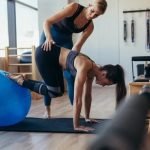Unilateral exercises, such as single-leg squats and lunges, have gained popularity in fitness training for their ability to target individual muscle groups and improve balance and stability. However, there are certain considerations to keep in mind when incorporating unilateral exercises into your routine, especially when it comes to RDL (Romanian Deadlift) fitness.
It is crucial to understand the benefits and risks of unilateral exercises in fitness training before diving into a routine that includes them. While these exercises can be effective in isolating muscles and improving overall strength, they also come with potential risks if not performed correctly. Additionally, their impact on specific exercises like the RDL can significantly affect your performance and results.
The Romanian Deadlift (RDL) exercise is a staple in many fitness routines for targeting the hamstrings, glutes, and lower back muscles. Understanding how unilateral exercises can influence your RDL fitness performance is important for maximizing the effectiveness of your workouts. By exploring alternatives to unilateral exercises and identifying common mistakes to avoid, you can make informed decisions to enhance your RDL fitness without compromising safety or results.
Benefits of Unilateral Exercises in Fitness Training
Unilateral exercises are a key component of many fitness training routines, providing a variety of benefits for overall strength, balance, and flexibility. These exercises involve working one side of the body at a time, challenging stability and targeting individual muscle groups for a more balanced physique. Here are some key benefits of incorporating unilateral exercises into your fitness routine:
- Improved Balance: Unilateral exercises help improve balance and coordination by working on stabilizing muscles that may not be as engaged during bilateral movements.
- Targeted Muscle Activation: By isolating one side of the body, unilateral exercises can target specific muscle groups more effectively, helping to address any imbalances or weaknesses.
- Increased Core Strength: Many unilateral exercises require greater core engagement to maintain stability, leading to improved core strength and overall functional fitness.
Moreover, unilateral exercises can also help prevent injury by addressing muscle imbalances and promoting symmetrical strength throughout the body. By incorporating these exercises into your fitness routine, you can enhance overall performance in activities like the Romanian Deadlift (RDL) exercise while reducing the risk of overuse injuries.
In order to maximize the benefits of unilateral exercises in RDL fitness performance, it is crucial to include a variety of movements that target different muscle groups on each side of the body. This will ensure comprehensive muscle activation and promote balanced strength development.
Additionally, proper form and technique are essential when performing unilateral exercises to avoid compensation patterns and reduce the risk of injury. Remember to gradually increase intensity and difficulty as you progress in your training program to continue challenging your muscles effectively.
Risks of Unilateral Exercises in Fitness Training
Unilateral exercises, while beneficial in many aspects of fitness training, also come with certain risks that individuals should be aware of before incorporating them into their workout routine. It is important to understand the potential drawbacks in order to make informed decisions about how to approach these exercises effectively and safely.
Some risks associated with unilateral exercises include:
- Increased risk of muscle imbalances: When focusing solely on one side of the body at a time, there is a possibility of developing muscle imbalances if one side becomes significantly stronger or weaker than the other. This can lead to poor posture, reduced performance, and an increased risk of injuries.
- Overuse injuries: Performing unilateral exercises excessively without proper rest and recovery can result in overuse injuries such as tendinitis or stress fractures. It is crucial to listen to your body and allow for adequate recovery between workouts.
- Compensatory movements: In an attempt to complete unilateral exercises with improper form or technique, individuals may unknowingly compensate with other muscles or body parts. This can not only diminish the effectiveness of the exercise but also increase the risk of injury over time.
In order to minimize the risks associated with unilateral exercises in fitness training, it is essential to incorporate a well-rounded workout routine that includes a variety of exercises targeting different muscle groups. Additionally, paying attention to proper form, gradually increasing intensity, and allowing for sufficient rest and recovery are key factors in preventing potential negative outcomes.
By being mindful of these risks and taking necessary precautions, individuals can still reap the benefits of unilateral exercises while reducing the likelihood of setbacks in their fitness journey.
What Is the RDL (Romanian Deadlift) Exercise?
The Romanian Deadlift (RDL) is a popular exercise in fitness training that primarily targets the hamstrings, glutes, and lower back muscles. Unlike traditional deadlifts, the RDL involves keeping your legs slightly bent and focusing on hip hinge movement while maintaining a straight back throughout the exercise. This variation places more emphasis on the posterior chain muscles and helps improve hip mobility and spinal erector strength.
Benefits of Including RDL in Your Fitness Routine
Incorporating the RDL into your workout routine can have numerous benefits for overall strength and muscle development. This exercise not only targets specific muscle groups efficiently but also helps improve core stability and balance. The controlled movement required during the RDL can also enhance muscle endurance and coordination, making it a valuable addition to any fitness program.
How to Properly Perform the RDL Exercise
To perform a proper RDL, start by standing with your feet hip-width apart and holding a barbell or dumbbells in front of your thighs with an overhand grip. Keeping your chest up and back straight, initiate the movement by pushing your hips back while bending at the waist. Lower the weights towards the ground while keeping them close to your body until you feel a stretch in your hamstrings.
Reverse the movement by engaging your glutes and hamstrings to return to standing position. Remember to keep a slight bend in your knees throughout the exercise to prevent strain on your lower back.
How Unilateral Exercises Impact RDL Fitness Performance
Unilateral exercises can have a significant impact on RDL (Romanian Deadlift) fitness performance. These exercises, which focus on training one limb at a time, are known for their ability to improve balance, stability, and strength in specific muscle groups. When it comes to RDL fitness, incorporating unilateral exercises can help target any muscle imbalances and weaknesses that may affect your performance.
Improving Muscle Symmetry and Balance
One of the key ways unilateral exercises can enhance RDL fitness performance is by improving muscle symmetry and balance. By isolating each limb, you can address any discrepancies in strength or stability between your left and right sides. This can help reduce the risk of injury during RDL workouts and ensure that both legs are working equally to support the movement.
Enhancing Core Stability
Another benefit of incorporating unilateral exercises into your RDL fitness routine is the enhancement of core stability. Many unilateral exercises require increased core activation to maintain proper form and balance throughout the movement. A strong core is essential for executing RDLs effectively, as it helps stabilize the spine and transfer power from the lower body to the upper body.
Increasing Functional Strength
Unilateral exercises also play a role in increasing functional strength, which is crucial for improving overall athletic performance, including RDL fitness. These movements mimic real-life activities where one side of the body may need to work independently from the other. By building strength unilaterally, you can improve your ability to perform RDLs with proper form and maximize your results in terms of strength gains and muscle development.
Alternatives to Unilateral Exercises for Enhancing RDL Fitness
Unilateral exercises are often praised for their ability to target stabilizing muscles, improve balance, and correct muscle imbalances in the body. However, when it comes to enhancing RDL Fitness (Romanian Deadlift Fitness), there are alternative approaches that can be just as effective. While unilateral exercises like single-leg deadlifts or lunges can be beneficial, they may not always be the best choice for everyone.
One alternative to unilateral exercises for improving RDL Fitness is the use of bilateral exercises. Bilateral exercises involve both limbs working together simultaneously, such as conventional deadlifts or barbell hip thrusts. These exercises allow individuals to lift heavier loads compared to unilateral exercises, which can lead to greater strength gains and muscle growth in the posterior chain – essential for optimal RDL performance.
Another alternative to unilateral exercises for enhancing RDL Fitness is incorporating stability and mobility drills into your workout routine. Exercises such as planks, bird dogs, or cat-cows can help improve core stability and hip mobility, which are crucial for maintaining proper form during RDL movements. By focusing on improving overall stability and mobility in key areas, individuals can better prepare their bodies for performing RDLs effectively without solely relying on unilateral exercises.
In addition to bilateral exercises and stability drills, another effective alternative for enhancing RDL Fitness is implementing resistance band variations of traditional RDL movements. Resistance bands provide accommodating resistance throughout the entire range of motion, challenging the muscles in different ways compared to free weights alone.
This can help individuals strengthen specific muscle groups necessary for RDLs while reducing the risk of injury often associated with heavy unilateral exercises. By incorporating these alternatives strategically into your workout routine, you can improve your RDL Fitness without solely relying on unilateral exercises.
| Alternative Approach | Benefits |
|---|---|
| Bilateral Exercises | Allows lifting heavier loads leading to greater strength gains |
| Stability and Mobility Drills | Improves core stability and hip mobility essential for proper form |
| Resistance Band Variations | Challenges muscles in different ways while reducing injury risk |
Common Mistakes to Avoid When Incorporating Unilateral Exercises in RDL Fitness
When incorporating unilateral exercises into your RDL fitness routine, it is essential to be aware of common mistakes that can hinder your progress and potentially lead to injury. One of the most significant mistakes to avoid is using improper form during unilateral exercises. This can not only reduce the effectiveness of the exercise but also increase the risk of strain or injury.
Another mistake to steer clear of is neglecting proper warm-up and cool-down routines before and after performing unilateral exercises. Failing to adequately prepare your muscles for the workout or help them recover afterward can result in muscle soreness, stiffness, and even long-term issues. Therefore, be sure to incorporate dynamic stretches and foam rolling into your routine.
Moreover, a common error when incorporating unilateral exercises in RDL fitness is progressing too quickly without mastering the foundational aspects of each exercise. It’s crucial to start with lighter weights and focus on proper technique before increasing intensity or resistance. Rushing this process can lead to decreased performance improvements and an increased risk of injury.
| Mistake | Impact |
|---|---|
| Improper Form | Reduced effectiveness, risk of strain or injury |
| Neglecting Warm-up/Cool-down | Muscle soreness, stiffness, long-term issues |
| Progressing Too Quickly | Decreased performance improvements, risk of injury |
Sample Workouts and Modifications for RDL Fitness Without Unilateral Exercises
When it comes to RDL fitness, incorporating unilateral exercises can have its benefits, but it is also important to understand that they are not the only way to improve your performance. In fact, there are alternative workouts and modifications that can help you enhance your RDL fitness without solely relying on unilateral exercises. By diversifying your routine, you can still achieve optimal results while reducing the risks associated with unilateral exercises.
One effective modification for RDL fitness without unilateral exercises is to focus on bilateral movements. This means performing exercises that engage both sides of your body simultaneously, such as squats or conventional deadlifts. These exercises not only help strengthen various muscle groups but also provide better stability and balance compared to unilateral movements. Incorporating bilateral movements into your routine can prevent muscle imbalances and reduce the risk of overuse injuries commonly associated with unilateral exercises.
Another alternative to unilateral exercises for improving RDL fitness is incorporating stability training into your workout routine. Exercises such as stability ball hamstring curls or Swiss ball hip bridges can help improve core strength and balance, which are essential for executing the RDL exercise properly. By including stability training in your workouts, you can enhance your overall performance in RDL fitness while minimizing the risks associated with solely focusing on unilateral movements.
Conclusion
In conclusion, it is essential to make informed decisions when incorporating unilateral exercises into your RDL fitness routine. While there are benefits to utilizing unilateral exercises for overall muscle balance and strength development, there are also risks associated with overreliance on them. It is crucial to strike a balance and consider the impact of unilateral exercises on your RDL fitness performance.
When aiming to enhance your RDL fitness, it is important to explore alternatives to unilateral exercises that can still effectively target the muscles engaged in the Romanian Deadlift. By incorporating a variety of exercises that focus on both sides of the body simultaneously, you can achieve a well-rounded workout routine that minimizes the risk of muscle imbalances or overuse injuries.
Ultimately, listening to your body and understanding its individual needs is key in creating a successful fitness routine. Whether you choose to incorporate unilateral exercises sparingly or opt for alternative methods altogether, the goal should always be to improve overall strength, mobility, and performance. By carefully considering the implications of each exercise on your RDL fitness goals, you can tailor your workouts to suit your unique needs and avoid potential pitfalls in your training journey.
Frequently Asked Questions
What Are the Disadvantages of Unilateral Exercises?
Unilateral exercises, while beneficial in many ways, do have some disadvantages. They can sometimes highlight muscle imbalances or weaknesses that can be more easily overlooked with bilateral exercises. Additionally, they may require more focus and coordination to perform properly.
Are Unilateral Exercises Necessary?
Including unilateral exercises in your workout routine is not necessarily a necessity, but it can be highly beneficial. These exercises help to improve balance, stability, and overall strength by targeting each side of the body independently. They also mimic real-life movements more closely than bilateral exercises.
Should You Do Unilateral Back Exercises?
Incorporating unilateral back exercises into your workout routine can be advantageous for improving symmetry and strength in the back muscles. By working each side of the back independently, you can address any muscle imbalances that may be present and prevent injuries in the long run. Examples of these exercises include single-arm rows or single-arm lat pulldowns.

Passionate about providing useful information to anyone with an interest in the field of Personal Training, I strive to pass on to our readers quality information and to answer any questions about Personal Trainers, the work they do and how to become one.





